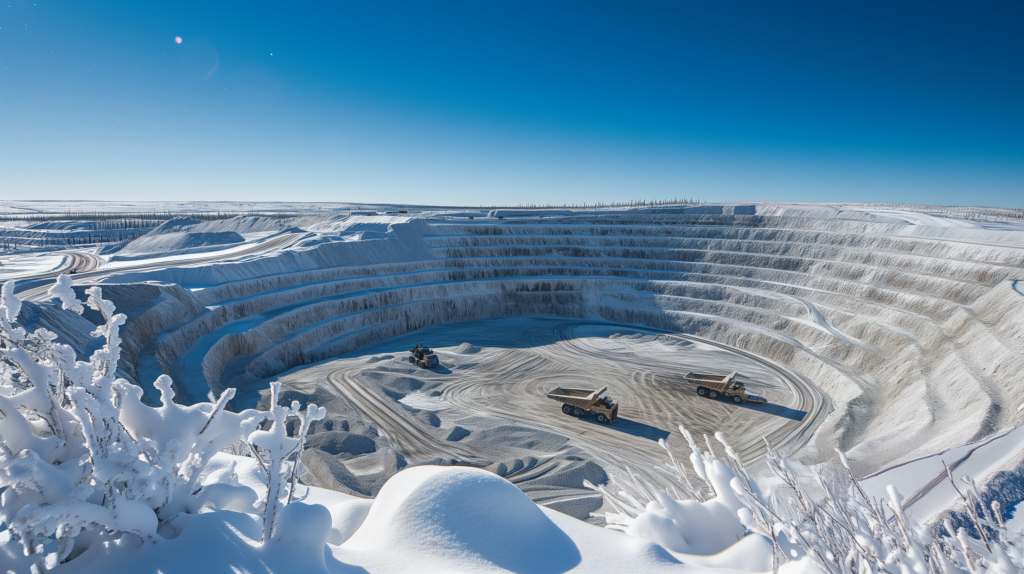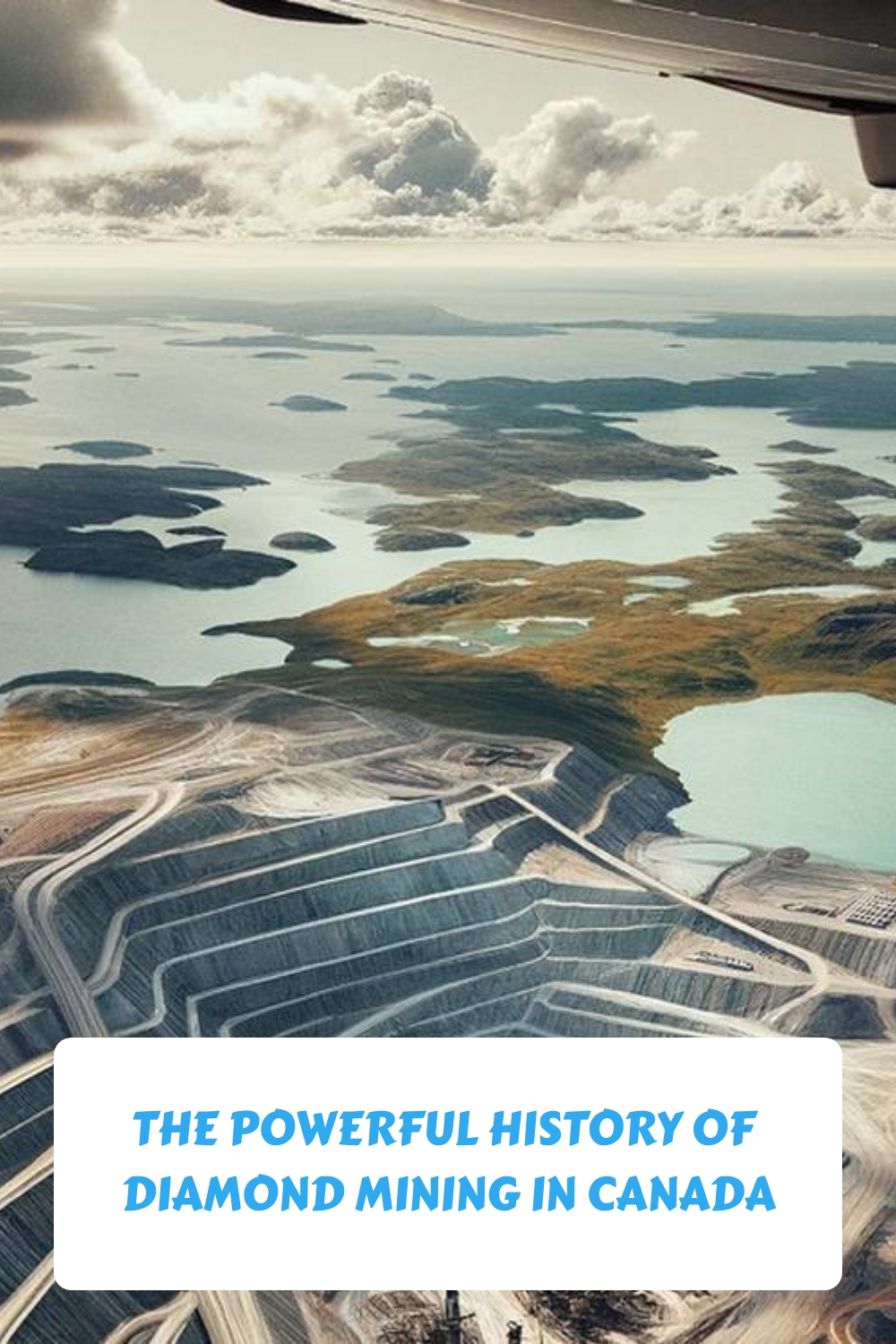Article Contents
- 1 Key Takeaways About The Canadian Diamond Industry
- 2 Introduction
- 3 Early History and Discovery
- 4 The Rise of the Canadian Diamond Industry
- 5 Technological Advancements and Mining Techniques
- 6 Environmental and Ethical Considerations
- 7 Economic Impact and Global Position
- 8 Cultural and Social Impact
- 9 Conclusion
- 10 Frequently Asked Questions
- 10.1 How Do Indigenous Land Rights and Claims Affect Diamond Mining Operations in Canada?
- 10.2 What Specific Measures Are Taken to Rehabilitate Land Post-Mining in Canadian Diamond Mines?
- 10.3 How Has the Pricing and Valuation of Canadian Diamonds Changed Over Time Compared to Diamonds From Other Parts of the World?
- 10.4 Are There Any Notable Diamonds or Stories of Extraordinary Discoveries Unique to Canadian Mines?
- 10.5 How Has Diamond Mining in Canada Affected Local Employment and Job Creation, Particularly in Remote Communities?
- 11 Further Reading About Diamond Mining in Canada
The exploration and extraction of diamonds in the stark yet majestic landscapes of Canada is a relatively recent chapter in the annals of mineral exploitation, yet it has rapidly evolved to position the nation as a significant player in the global diamond industry.
The narrative of diamond mining in Canada began in earnest in the early 1990s, when impressive deposits were discovered in the Northwest Territories, disrupting the industry’s traditional centers and altering international trade dynamics.
As we trace the history of this lucrative enterprise from its serendipitous discovery to its current status, we uncover a complex tapestry woven with technological innovation, environmental stewardship, and socio-economic transformations.
Considering the multifaceted impact of this industry, the implications for Canada and the global market are profound and merit a closer look at the intricate layers that constitute the history of diamond mining within this nation’s vast and varied terrain.
Key Takeaways About The Canadian Diamond Industry
- Canada has emerged as a pivotal player in the global diamond mining industry, significantly impacting the global diamond market.
- The discovery of diamonds in Canada in the 1990s led to the rise of the Canadian diamond industry, with the establishment of the first mines such as Ekati and Diavik.
- Canada has implemented sustainable and ethical mining practices, including wildlife conservation measures, to mitigate the environmental impact of diamond mining.
- The diamond mining industry in Canada has had significant economic and social implications, including job creation, support for local communities, and enhancement of trade balance through international trade.
Introduction
Diamond mining is a significant sector of the global mining industry, distinguished not only by the value and various applications of the gemstones but also by the stringent ethical and environmental standards associated with their extraction.
Within this context, Canada has emerged as a pivotal player, contributing a substantial share of the world’s diamond supply since the discovery of rich deposits in the early 1990s.
This introduction provides an analytical examination of the global diamond mining landscape, with a focused perspective on Canada’s evolution as a reputable source in the diamond mining industry.
A brief overview of diamond mining globally
Globally, the quest for gem-quality stones fuels an intricate industry dedicated to the extraction of diamonds from vast tracts of the earth’s crust. Diamond formation takes place under high-pressure, high-temperature conditions deep within the Earth, before they are brought to the surface through volcanic activity. These natural processes create the uniquely structured crystals that have captivated humans for centuries, making diamonds symbols of luxury and endurance. However, the growing market for traditional versus labgrown diamonds has sparked significant discussions around sustainability and ethical sourcing. Lab-grown alternatives, created using advanced technology, offer an environmentally friendly and conflict-free option, reshaping consumer preferences in the modern jewelry industry.
Gemstone trading has evolved with stringent international regulations to prevent conflict diamonds from entering the market, fostering a more ethical environment for commerce. Moreover, synthetic alternatives are gaining ground as technological advancements make lab-grown diamonds more accessible and appealing. This shift reflects a growing consumer demand for transparency and sustainability in the jewelry industry. Many buyers now prioritize ethically sourced natural diamonds, seeking assurances about their origin and the conditions under which they were mined. By combining greater accountability with the rise of innovative alternatives, the gemstone market is becoming more attuned to modern ethical and environmental values.
Market trends continue to influence the industry, with consumer preferences shifting and new discoveries affecting supply dynamics.
- Diamond formation occurs over billions of years, often hundreds of kilometres below the earth’s surface.
- Gemstone trading is regulated by entities such as the Kimberley Process to ensure ethical sourcing.
- International regulations are in place to maintain transparency and prevent the trade of illicit diamonds.
- Synthetic alternatives provide a conflict-free and often more affordable option for consumers.
- Market trends are closely monitored as they dictate production strategies and consumer demand.
Introduction to Canada’s role in the diamond mining industry.
Emerging as a significant player in the latter part of the 20th century, Canada has swiftly ascended the ranks in the global diamond mining industry, distinguished by its ethical sourcing and modern environmental standards.
Groundbreaking geological surveys have revealed substantial diamond-bearing kimberlite pipes, which subsequent exploration technology has transformed into viable mining prospects.
The country’s approach to diamond valuation is meticulous, aligning with jewelry market trends that favor responsibly mined gems.
Indigenous partnerships are integral to the operation, underscoring a commitment to the rights and participation of First Nations communities.
Canada’s diamond mining narrative is a testament to innovative exploration, respectful collaboration, and strategic market engagement, positioning it as a paragon of responsible resource development in the international arena.

Early History and Discovery
Prior to the 1990s, the geological landscape of Canada was not widely recognized for its diamond potential, although the country’s vast mineral resources had long been acknowledged.
The landmark discovery of diamonds in the Lac de Gras region of the Northwest Territories marked a significant turning point in the history of Canadian mining, prompting a reevaluation of the nation’s mineral wealth.
This initial breakthrough, however, was met with a series of technical and logistical hurdles that shaped the early phase of diamond exploration and mining in Canada.

Pre-discovery era: Geology of Canada and potential for diamond deposits
The ancient geological landscape of Canada, with its cratonic roots extending deep into the Earth’s mantle, hinted at the country’s potential to harbor significant diamond deposits long before their actual discovery. The pre-discovery era’s rock formations, shaped by eons of tectonic activity, were largely unexplored, yet they presented an auspicious setting for mineral exploration. Sedimentary basins, often repositories of rich natural resources, coupled with the geological signatures of Kimberlite pipes, were telltale signs for geologists in pursuit of precious stones.
- Cratonic Platforms: Stable regions offering favorable conditions for diamond stability and preservation.
- Kimberlite Pipes: Primary sources of diamonds, formed by deep-source volcanic eruptions.
- Tectonic Activity: Contributed to the exposure and accessibility of Kimberlite pipes.
- Mineral Exploration: Techniques evolved to identify geophysical anomalies indicative of Kimberlite.
- Sedimentary Basins: Potential hosts for secondary diamond deposits transported by natural processes.
The discovery of diamonds in Canada in the 1990s
Building upon the foundational knowledge of Canada’s favorable geology, the 1990s marked a pivotal era with the groundbreaking discovery of diamondiferous Kimberlite pipes in the country’s remote northern regions.
The identification of Kimberlite formations near Lac de Gras ignited a surge in exploration activities, employing advanced prospecting techniques that had not previously been extensively applied in Canada for diamond exploration. Teams of geologists utilized geophysical surveys to delineate subsurface structures indicative of Kimberlite, a rock type known to host diamonds.
Following these scientific leads, prospectors systematically staked claims over promising areas, securing the rights to explore and potentially mine these resources. This strategic combination of cutting-edge technology and methodical claim staking during the 1990s set the stage for Canada’s ascent in the global diamond mining industry.
Initial challenges and developments
Embarking on the exploitation of Canada’s newfound diamond wealth was fraught with challenges. These challenges included the harsh climate, the difficulty in accessing remote locations, and the considerable financial investment required for establishing mining infrastructure.
The Arctic weather imposed severe operational constraints. Extreme temperatures and weather patterns complicated mining operations, making it challenging to work efficiently and effectively.
Remote logistics also presented a significant hurdle. The remote nature of the mining sites meant that transporting equipment and personnel to these isolated locations was difficult. Innovative transport solutions were necessary to overcome these logistical challenges.
Exploration funding was critical to undertake extensive geological surveys and drilling programs. The high costs associated with preliminary exploration and subsequent stages of mine development needed to be covered to assess the potential of these diamond-rich areas fully.
Additionally, respectful Indigenous partnerships were paramount. Collaboration with Indigenous communities was crucial to secure their support and ensure that the mining activities aligned with their values and rights. Benefit sharing was also an essential aspect of these partnerships.
Furthermore, wildlife conservation efforts were necessary to mitigate the ecological impact of mining operations. Measures needed to be implemented to protect local biodiversity during the mining process. These efforts were crucial to maintaining the ecosystem’s delicate balance in these remote areas.
The Rise of the Canadian Diamond Industry
The Canadian diamond industry experienced a significant surge following the operational commencement of the Ekati mine in 1998, closely followed by the Diavik mine in 2003.

These pivotal developments not only bolstered Canada’s standing as a major player in the global diamond market but also introduced a new era of ethical sourcing and production standards.
The consequent economic and social benefits have been considerable, transforming local communities and contributing to the national economy through job creation and export revenues.
The establishment of the first mines (Ekati and Diavik)
In the early 1990s, Canada emerged as a new player in the global diamond mining industry with the establishment of the Ekati and Diavik mines in the Northwest Territories. These forerunners of the Canadian diamond industry marked a significant shift in global markets, introducing fresh competition and new exploration techniques.
The mines were developed with a keen awareness of the sensitive Arctic ecosystem, under a strict regulatory framework designed to safeguard the environment and respect the rights of indigenous communities. Mine ownership was structured to ensure a beneficial partnership between private companies and public interests, reinforcing Canada’s commitment to responsible resource management.
- Arctic ecosystem: Prioritized environmental protection during mining operations.
- Mine ownership: Collaborations between private entities and government.
- Global markets: Canada’s entry challenged existing diamond suppliers.
- Exploration techniques: Advanced technology for minimal environmental impact.
- Regulatory framework: Laws ensuring sustainable and ethical mining practices.
Impact on the global diamond industry
Canada’s entry into the diamond mining sector rapidly transformed the landscape of the global diamond industry. It introduced innovative practices and shifted market dynamics with its high-quality gemstone production. The rise of the Canadian diamond industry influenced diamond valuation by adding a new source of premium gems. These gems are prized for their ethical sourcing and traceability. This attribute has been particularly appealing for consumers and investors concerned with ethical considerations in the jewelry market.
Furthermore, Canadian diamonds emerged as a competitive alternative to synthetic diamonds. This bolstered the market’s preference for natural stones. Canada’s stringent global regulations and standards have led to an increased focus on responsible mining practices in the industry. These developments have affected investment trends, influencing stakeholders to prioritize sustainable and ethical choices in their portfolios.
Harnessing the wealth of its subterranean treasures, Canada has experienced a significant economic boost and profound social changes stemming from the ascent of its diamond mining industry.
- Diamond Legislation: Sturdy regulations have enhanced the industry’s transparency and accountability, which in turn solidify Canada’s reputation for ethically sourced diamonds.
- Import Tariffs: Strategic adjustments in import tariffs have incentivized domestic processing, bolstering the local jewelry industry and expanding job opportunities.
- Consumer Demand: The rise in consumer demand for Canadian diamonds has stimulated economic activity and generated substantial revenue through exports.
- Jewelry Industry: Growth in the jewelry sector due to increased diamond availability has fostered entrepreneurial ventures and artisanal craftsmanship.
- Trade Agreements: Canada’s participation in various trade agreements has facilitated the entry of Canadian diamonds into international markets, strengthening trade partnerships.
The industry’s development has been meticulous, leveraging legislation, market strategies, and global partnerships to ensure that Canada’s diamond wealth translates into enduring prosperity and liberty for its people.
Technological Advancements and Mining Techniques
The implementation of cutting-edge mining methods in Canadian diamond mines has been a cornerstone of the industry’s evolution, enhancing both operational efficiency and environmental stewardship.
Technological advancements, such as X-ray fluorescence (XRF) sorting and laser technology, have revolutionized the sorting and valuation processes, setting new benchmarks for accuracy and speed.
These innovations, juxtaposed with global diamond mining techniques, underscore Canada’s position as a leader in sustainable and effective diamond extraction practices.

Overview of mining methods used in Canadian diamond mines
In Canadian diamond mines, a combination of open-pit and underground mining techniques is employed, utilizing cutting-edge technology and innovative methods to extract diamonds from the depths of the Canadian Shield. This approach ensures the efficient recovery of gem-quality stones while adhering to stringent environmental standards and safety protocols.
- Underground exploration: Leveraging geotechnical analysis to pinpoint diamond-rich Kimberlite pipes beneath the Earth’s surface.
- Kimberlite processing: Innovating in the extraction and crushing procedures to maximize diamond liberation from host rock.
- Open pit challenges: Strategically managing the removal of overburden to access Kimberlite deposits, while mitigating environmental impact.
- Tailings management: Employing sophisticated methods to responsibly handle waste material post-Kimberlite processing.
- Alluvial prospects: Scouting for secondary diamond deposits in riverbeds, using less invasive techniques that preserve the ecosystem.
Technological advancements and their impact on efficiency and environmental sustainability
Advancements in mining technology have significantly elevated both the efficacy of diamond extraction and the environmental sustainability of operations within Canada’s diamond mining industry.
Mining robotics, for instance, has introduced precision and safety, reducing the environmental footprint and increasing the yield of high-quality gemstones. These innovations are not just responses to consumer trends that increasingly prioritize sustainability but also adaptations to the competitive pressure from synthetic diamonds.
The rise of lab-grown gemstone alternatives is reshaping jewelry design and consumer demand, compelling the industry to streamline operations. Enhanced recovery methods have been developed to maximize the extraction of diamonds from ore, minimizing waste and reducing the overall impact on the natural landscape.
The integration of these technologies reflects an industry striving to harmonize profitability with environmental stewardship.
Comparison with other diamond mining methods worldwide
Compared to traditional diamond mining practices worldwide, Canada’s use of cutting-edge technology and innovative mining techniques stands as a testament to its commitment to efficiency and environmental responsibility. While the South African giants have historically set the stage for diamond extraction, Canadian methods emphasize minimal environmental footprint and sustainability.
- Alluvial mining techniques: Often lead to soil erosion and water siltation, contrasting Canada’s more contained approach.
- Kimberlite pipe formation: Exploited with precision in Canada to reduce surface disruption.
- Lab-grown alternatives: Gaining traction, yet Canada maintains its niche in responsibly mined natural diamonds.
- Artisanal mining impacts: Known for labor and environmental issues, a stark contrast to Canada’s regulated and technologically advanced operations.
- South African giants: Their legacy of extensive mining contrasts with Canada’s focus on targeted, low-impact extraction processes.
Environmental and Ethical Considerations
The extraction of diamonds in Canada necessitates a rigorous examination of its environmental footprint, particularly in terms of ecological disturbance and carbon emissions.
Canadian diamond producers are increasingly adopting sustainable mining practices, yet the efficacy and consistency of these measures require ongoing scrutiny.
Internationally, Canadian mining standards are often juxtaposed with practices in other regions, highlighting both areas of leadership and opportunities for further improvement within the industry’s ethical landscape.
Environmental impact of diamond mining in Canada
Diamond mining in Canada is a significant contributor to the national economy. However, it also presents a range of environmental challenges. These challenges include ecosystem disruption, wildlife displacement, and water quality degradation. In order to address these issues, a detailed understanding of the environmental footprint of diamond extraction and processing is necessary. This understanding should encompass not only immediate impacts but also long-term ecological consequences.

One of the major environmental challenges associated with diamond mining is water contamination. Effluents from mining operations can lead to significant water quality issues, which can have detrimental effects on both aquatic life and human health.
Another significant concern is the carbon footprint of diamond mining. The energy-intensive nature of mining contributes to greenhouse gas emissions, exacerbating climate change.
Wildlife disruption is also a major issue. Habitats are disturbed, and species are often forced to relocate, which can upset ecological balances.
To mitigate the damage caused by diamond mining, reclamation processes are critical. These processes aim to restore the land post-mining, although they can never fully replicate the original ecosystem.
Efforts to rehabilitate ecosystems also play a crucial role. These efforts focus on soil regeneration, reintroduction of native flora and fauna, and stabilization of landscapes.
Efforts towards sustainable and ethical mining practices
Recognizing the environmental and social impacts of diamond extraction, Canadian mining companies are increasingly investing in sustainable practices and technological innovations to minimize their ecological footprint and adhere to ethical standards. These entities are combatting the issue of conflict diamonds by strictly adhering to the Kimberley Process, ensuring diamonds are conflict-free. Moreover, they are improving the oversight of artisanal mining, reducing its adverse effects on both the environment and local communities.
Amid market fluctuations, maintaining high gemstone quality while committing to ethical sourcing is paramount. Canadian diamond producers are leading by example, implementing rigorous environmental management systems and prioritizing the well-being of indigenous populations. These advancements represent a steadfast commitment to responsible stewardship of natural resources, reflecting a balance between industry growth and moral accountability.
Comparison with diamond mining in other regions
While Canadian mining companies have set a precedent for sustainable and ethical diamond mining practices, it is instructive to compare their efforts with operations in other regions where environmental and ethical standards may differ significantly.
- African mines comparison: Many African mines face scrutiny for less stringent environmental controls and ethical issues like labor exploitation.
- Australian mining practices: Australia’s mining sector, though highly regulated, has been criticized for its impact on indigenous lands and water resources.
- Russian extraction techniques: Russian diamond extraction often prioritizes economic gain over environmental stewardship, leading to significant ecological disruption.
- Botswanan economic impact: Botswana’s diamond mining is crucial economically but poses challenges in balancing growth with conservation of the natural environment.
- South African legislation: South Africa has implemented comprehensive mining laws, but enforcement inconsistencies occasionally undermine environmental and social protections.
Economic Impact and Global Position
Diamond mining significantly contributes to the Canadian economy in several ways. Firstly, it provides jobs for many Canadians, creating employment opportunities and supporting local communities. Additionally, diamond mining drives investment in the country, attracting both domestic and foreign investors who see the potential for growth and profitability in the industry. Moreover, the sector generates revenue through exports, as Canadian diamonds are highly sought after in the international market.
Currently, Canada holds a competitive position in the global diamond market. In terms of value, it ranks among the top five diamond-producing countries worldwide. This achievement speaks to the quality and desirability of Canadian diamonds, which are known for their exceptional clarity and color.
However, the diamond mining sector in Canada also faces challenges and uncertainties. The future prospects of the industry depend on various factors, such as market demand, technological advancements, and the ability to navigate socio-political challenges inherent to natural resource extraction.
Contribution of diamond mining to the Canadian economy
Canada’s diamond mining industry plays a significant role in bolstering the nation’s economy, contributing to its global standing as one of the top diamond producers by value. Diamond valuation has become an intricate part of the Canadian economy, with market fluctuations influencing both the mining sector and the international trade landscape. The country’s ability to adapt to changing consumer demand is pivotal to its success, particularly in the jewelry manufacturing industry.
- Diamond Valuation: Reflects the economic stability and investment potential of the Canadian mining sector.
- Market Fluctuations: Affects revenue and dictates strategic planning within the industry.
- International Trade: Enhances Canada’s trade balance and strengthens foreign relations.
- Jewelry Manufacturing: Boosts local industries and generates employment.
- Consumer Demand: Drives innovation and sustains the market for Canadian-mined diamonds.
Canada’s position in the global diamond market
Building upon its substantial economic contributions, the Canadian diamond mining industry secures a prominent position in the global market, underpinned by its reputation for quality and adherence to ethical mining practices. This industry competes effectively against other modes of production, such as artisanal mining, which often lacks the stringent ethical standards Canada upholds. Furthermore, despite the rise of synthetic alternatives, the demand for Canadian-mined diamonds remains robust, driven by luxury marketing that emphasizes their authenticity and provenance.
| Factor | Influence on Canada’s Position |
|---|---|
| Diamond Valuations | High-quality reserves boost market value |
| Artisanal Mining | Ethical standards distinguish Canadian diamonds |
| Synthetic Alternatives | Natural diamonds maintain allure despite competition |
| Global Trade | Strong trade networks support exportation |
| Luxury Marketing | Emphasizes the origin and ethics, enhancing appeal |
Canada’s strategic approach to global trade and luxury marketing ensures its diamonds are highly valued within the freedom-seeking segments of the market.
Future prospects and potential challenges
Looking towards the future, the Canadian diamond mining industry faces a complex interplay of challenges and opportunities that will shape its economic impact and position on the global stage. As the sector evolves, the following points merit close attention: First, the industry must navigate increasing environmental and social responsibility pressures while maintaining operational efficiency. Second, the development of new technologies and exploration methods will be critical for future diamond production. Lastly, heightened competition and market volatility will require innovative strategies to ensure sustained growth and success in the coming years.
- Robotic Automation: Advancements may reduce labor costs and increase safety, but also lead to a workforce transition.
- Market Fluctuations: Global economic shifts can affect diamond prices and demand, influencing profitability.
- International Trade: Trade policies and agreements will continue to shape Canada’s export dynamics.
- Exploration Technologies: Innovations in exploration can lead to new discoveries, securing Canada’s position as a leading diamond producer.
- Synthetic Alternatives: The rise of lab-grown diamonds presents competition, potentially eroding market share for natural diamonds.
Cultural and Social Impact
The cultural and social fabric of communities surrounding Canadian diamond mines, particularly indigenous populations, has been significantly influenced by the industry’s presence. While the creation of jobs has spurred social development in these regions, it is imperative to assess whether the employment opportunities provided are commensurate with the impact on traditional ways of life.
Mining corporations have responded with corporate social responsibility programs, though the effectiveness and depth of these initiatives require careful analysis to ensure they align with the long-term interests of the affected communities.

The effect on indigenous communities and local populations.
How has the expansion of diamond mining in Canada impacted the cultural and social dynamics of indigenous communities and local populations? The incursion of mining operations has often led to substantial transformations within these communities, affecting various aspects of life and the environment. These changes are multifaceted, with both potentially positive and adverse consequences.
- Traditional livelihoods disrupted: Hunting, fishing, and other subsistence practices have been affected.
- Land claim disputes: Tensions have arisen over land rights and resource entitlement.
- Wildlife habitat alteration: Critical ecosystems have been disturbed, impacting biodiversity.
- Community health concerns: The introduction of new activities has raised questions about physical and mental health outcomes.
- Cultural heritage preservation: Efforts to maintain and protect cultural identities are challenged by industrial development.
While the arrival of diamond mining operations has undeniably disrupted indigenous and local ways of life, it has concurrently ushered in new employment opportunities and avenues for social development within these communities.
Labor dynamics have shifted as mining companies offer vocational training, leading to skilled employment in the industry. This mining education, often provided through partnerships with local institutions, equips residents with valuable expertise, bolstering their professional autonomy.
Furthermore, mining corporations have invested in community health initiatives and recreational infrastructure, enhancing the quality of life and fostering well-being. Local entrepreneurship has flourished too, as ancillary businesses emerge to support the mining ecosystem.
Collectively, these changes are reshaping the socioeconomic fabric of mining areas, providing avenues for sustainable development and self-determination.
Acknowledging their influential role in remote communities, diamond mining companies in Canada have launched various corporate social responsibility (CSR) initiatives aimed at cultural preservation and social enhancement. These initiatives are meticulously designed to align with the ethos of freedom and autonomy that the communities value.
They include:
- Commitment to ethical sourcing, ensuring that mining practices do not harm the environment or violate human rights.
- Enhanced community engagement programs to facilitate meaningful dialogue and incorporate indigenous knowledge.
- Active stakeholder collaboration, forming partnerships with local governments and organizations to support community development.
- Adherence to international standards for labor and environmental practices to foster a sustainable mining sector.
- Transparent reporting mechanisms that allow the public to assess the impact of mining activities and the effectiveness of CSR efforts.
Such detailed, analytical approaches exemplify how Canadian diamond mining companies strive to operate responsibly and conscientiously within the communities they affect.
Conclusion
In summary, Canada’s ascent in the diamond mining industry marks a significant chapter in the nation’s economic development, characterized by sustainable practices and technological advancements.
Looking ahead, the longevity and evolution of Canadian diamond mining hinge on balancing economic interests with environmental stewardship and indigenous partnerships.
It is clear that Canada’s influence on the global diamond market is poised to grow, contingent on its adherence to ethical mining standards and response to market demands.
Summary of Canada’s journey in diamond mining
Canada’s ascent in the diamond mining industry has been a remarkable journey, marked by significant discoveries and advancements in extraction techniques since the early 1990s. The nation’s strides are not just a tale of geological fortune but also of a steadfast commitment to sound exploration techniques, comprehensive geological surveys, and astute diamond valuation, all while navigating market trends and the emergence of synthetic alternatives.
This pursuit has been underpinned by a spirit of liberty, allowing for innovative practices and responsible exploitation of mineral wealth.
- Pioneering exploration techniques leading to major kimberlite discoveries
- Advanced geological surveys mapping the vast, yet accessible northern territories
- Precise diamond valuation methods ensuring Canada’s stones compete globally
- Adaptation to market trends, balancing supply with global demand
- Strategic response to synthetic alternatives, emphasizing the natural diamond’s value
Reflection on the future of diamond mining in Canada
As the horizon of diamond mining in Canada approaches, industry stakeholders are contemplating the sustainability and economic viability of this sector in the face of evolving global markets and technological advancements.
| Factor | Current Status | Future Outlook |
|---|---|---|
| Exploration Technology | Advanced geophysical tools in use | Further innovation expected |
| Global Demand | Steady with luxury market growth | Possible shifts due to diamond alternatives |
| Reserve Depletion | Some mines nearing end of life | Need for new discoveries and mines |
| Carbon Footprint | Efforts to reduce emissions underway | Increased pressure to minimize impact |
The industry must navigate the challenges of reserve depletion while also addressing the carbon footprint associated with extraction processes. Innovations in exploration technology will be crucial to discovering new deposits. Simultaneously, the emergence of diamond alternatives may reshape global demand, necessitating a strategic response to maintain Canada’s position in the diamond market.
Closing thoughts on the industry’s global impact
The global impact of Canada’s diamond mining industry extends well beyond its national borders, influencing international markets and setting standards for environmental and ethical mining practices. Canada’s emergence as a diamond producer has reverberated through the industry, impacting global legislation and stabilising market fluctuations.
Even in the face of international conflicts that can disrupt commodity channels, Canadian diamonds have maintained a reputation for conflict-free status, which aligns with evolving jewelry trends that prioritize ethical sourcing. Moreover, the country’s commitment to science innovations in mining technology is setting a new benchmark for operational efficiency and environmental conservation.
- Global legislation influenced by Canada’s ethical mining standards
- Market fluctuations moderated by Canada’s stable diamond supply
- Mitigation of international conflicts through Canada’s conflict-free diamonds
- Jewelry trends shaped by consumer demand for ethically sourced Canadian diamonds
- Science innovations driven by Canada’s investments in sustainable mining practices
Frequently Asked Questions
How Do Indigenous Land Rights and Claims Affect Diamond Mining Operations in Canada?
Indigenous land rights significantly influence Canadian diamond mining through partnerships, treaty negotiations, and legal precedents, ensuring environmental stewardship and cultural impact considerations are integral to operations, affirming a commitment to freedom and ethical practices.
What Specific Measures Are Taken to Rehabilitate Land Post-Mining in Canadian Diamond Mines?
Canadian diamond mines implement landscaping strategies, water treatment, and the establishment of wildlife corridors. They reintroduce native vegetation and conduct rigorous monitoring of ecosystems to ensure successful land rehabilitation post-mining.
How Has the Pricing and Valuation of Canadian Diamonds Changed Over Time Compared to Diamonds From Other Parts of the World?
Canadian diamond pricing is influenced by market trends, global competition, and ethical sourcing perceptions, enhancing their investment value. Synthetic alternatives have also affected valuation, requiring careful analysis to maintain their competitive position.
Are There Any Notable Diamonds or Stories of Extraordinary Discoveries Unique to Canadian Mines?
Canadian mines, like the frosty treasures of Snap Lake or Gahcho Kué, have yielded their share of remarkable stones since the Ekati Opening and Diavik Discovery, further enriching the narrative of Victor Mine’s bounty.
How Has Diamond Mining in Canada Affected Local Employment and Job Creation, Particularly in Remote Communities?
Diamond mining in Canada has bolstered economic diversification, fostering community partnerships and workforce training. It provides seasonal employment opportunities and spurs infrastructure development, contributing to enhanced autonomy in remote, employment-challenged regions.
Further Reading About Diamond Mining in Canada
Here are some authoritative pages about diamond mining in Canada:
- The Government of Canada’s Natural Resources website provides information on Canada’s diamond industry, including production statistics, exploration, and mining regulations. (https://www.nrcan.gc.ca/mining-materials/minerals-mining/diamonds/20513)
- The Diavik Diamond Mine, located in Canada’s Northwest Territories, is one of the country’s largest diamond producers. The mine is operated by Rio Tinto and has implemented sustainable practices, such as building a solar power plant to reduce greenhouse gas emissions. (https://www.reuters.com/markets/commodities/rio-tinto-build-solar-plant-power-diavik-diamond-mine-canada-2023-08-10/)
- The book “Mining and Communities in Northern Canada: History, Politics, and Memory” by Arn Keeling and John Sandlos provides a comprehensive overview of the social, environmental, and political impacts of mining in Canada’s North, including diamond mining. (https://library.oapen.org/bitstream/id/4ec9887e-01c5-4fed-9694-0aaba5d44172/9781552388051.pdf)
- De Beers Group, one of the world’s largest diamond producers, has released its tenth annual Diamond Insight Report, which focuses on the outlook for diamonds in China and how the industry can support long-term demand for diamond jewelry. The report also includes authoritative data on the performance of the diamond industry’s upstream, midstream, and downstream segments in 2022. (https://www.debeersgroup.com/media/company-news/2023/db-research-insights-highlight-opportunities-for-long-term-diamond-jewellery-demand-growth-in-china)
- The article “Socio-environmental impacts of diamond mining areas in the Canadian Arctic” published in the journal Resources Policy discusses the socio-environmental impacts of diamond mining in Canada’s Arctic region. (https://www.sciencedirect.com/science/article/abs/pii/S0048969721071138)



